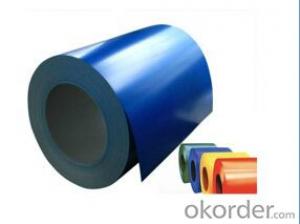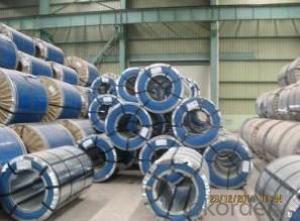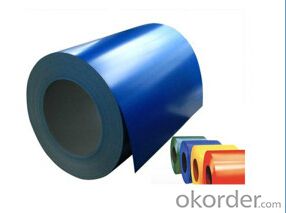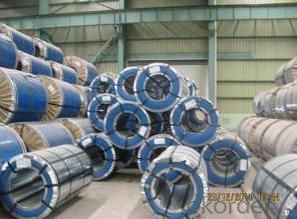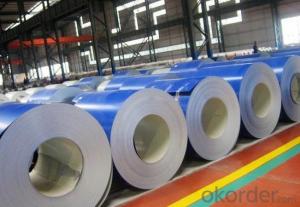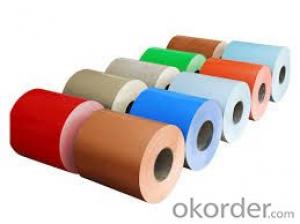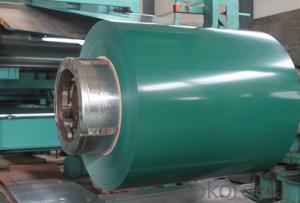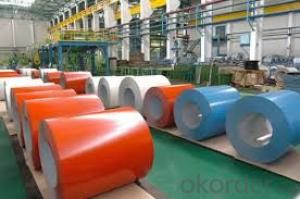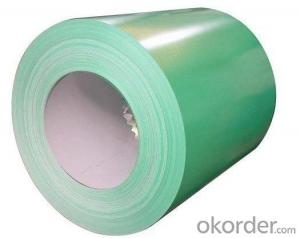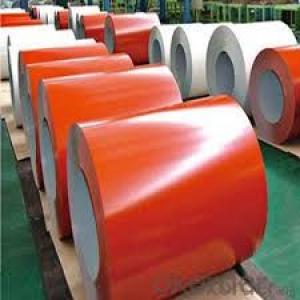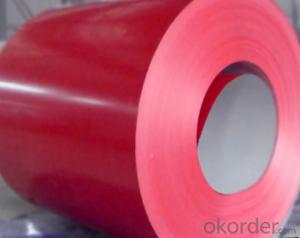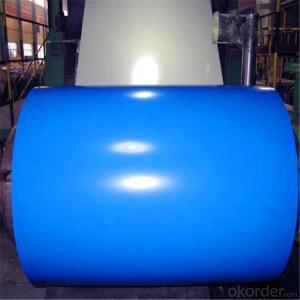0.3mm Thickness PPGI Prepainted Galvanized Steel Coil
- Loading Port:
- Shanghai
- Payment Terms:
- TT OR LC
- Min Order Qty:
- 30 m.t.
- Supply Capability:
- 10000 m.t./month
OKorder Service Pledge
OKorder Financial Service
You Might Also Like
Basic Info.
Model NO.:DX51d SGCC DX52d
Surface Treatment:Coated
Certification:ISO, SGS
Technique:Hot Dipped
Standard:ASTM, JIS, GB, AISI, DIN, BS
Application:Boiler Plate
Edge:Slit edge
Stock:Stock
Steel Grade:Dx51d
Thickness:0.3mm
Width:1250mm
Top Paint:15+5
Back Paint:5-7
ID:508mm
Coil Weight:3-8 Tons
Zinc Coating:50g-250g/Psm
Gloss:65%-80%
Feedback:Within 24 Hours
Export Markets:Global
Additional Info.
Packing:Export Standard Package
Standard:AISI, ASTM, BS, DIN, GB, JIS
Origin:Shandong
HS Code:7210701000
Production Capacity:150, 000tons/Year
Product Description
Specifications:
1. Thickness: 0.12mm-1.3mm
2. Width: 600mm-1250mm
3. Length: According to client's demands
4. Top paint: 15 to 25 um (5 um + 12-20 um)
Back paint: 7 +/- 2 um
5. Gloss: Normal or High gloss
6. Zinc coating: Z50-Z275G/psm
7. Inside Diameter: 508mm/610mm
8. Outside Diameter: 1000mm-1500mm
9. Coil weight: 3-8 tons
10. Payment: T/T, L/C, D/P, Paypal, Western Union
11. Trade Term: FOB, CFR, CIF
12. MOQ: 30 Mt
13. Package: Export standard package or as request
14. Shipment: By container
15. Standard: AISI, ASTM, BS, DIN, GB, JIS
16. Grade: JIS G3322, CGLCC, ASTM A755, CS-B
- Q: How do steel coils compare to other materials in terms of cost?
- Steel coils are generally more cost-effective compared to other materials. Steel is a widely available and abundant material, which makes it relatively inexpensive to produce. Additionally, steel coils have a longer lifespan and require minimal maintenance, reducing overall costs in the long run. The durability and strength of steel also make it an ideal choice for various applications, further enhancing its cost-effectiveness. When compared to materials like aluminum or copper, steel coils tend to be more affordable, making them a preferred choice for many industries.
- Q: describe the benifits and disadvantages of the using steel as a material for fasteners
- Relatively cheap, strong, and non-toxic. For Carbon Steel alloys rust and corrosion are problems. For stainless alloys, cost becomes the problem [and corrosion is not eliminated]
- Q: what is the difference between METAL and STEEL?
- Metal is the generic name for several pure chemical elements and they alloys that can be made from them. Steel is used to designate alloys that consist mainly of iron, with a limited proportion of carbon in them.
- Q: I want to buy a chain that will last a long time and that i can wear ALL the time.What are the disadvantages to stainless steel jewelry?Does it look as good as silver?Is there much diference in apperance?
- Benefits Of Stainless Steel Jewelry
- Q: What are the different coil slitting line configurations used for steel coils?
- There are several different coil slitting line configurations used for steel coils, including the looping pit slitting line, the looping tower slitting line, the non-looping slitting line, and the traveling head slitting line. Each configuration offers unique advantages and is suited for specific applications and production requirements.
- Q: for instance Cr-Ni steeldoes this refer to plated steel or a uniform mixture
- stainless steel is an alloy normally iron with additions of C, Mn, Ni, Cr, and Nb - amounts added depend on properties required. Corrosion resistance is due to a very thin but dense layer of chromium oxide which forms at the surface and prevents further attack. Ordinary steel on the other hand becomes coated with a porous layer of iron oxide(rust) through which the atmosphere can pass and cause further corrosion.
- Q: I'v had 5 people at school say steel is stonger than Titanium and some(5) kids at school say titanium stronger then steel but i looked it up on the internet and i got soem web sites that say steel is stronger then titanium and some sites that say titanium is stonger then steel sooooo???? witch one is strongerPS i no tungsten is stronger then steel.... and titanium.................
- Titanium has better high temperature strength than steel. Titanium doesn't resist shocks like steel can. It's more brittle. It's also far more difficult to weld. Titanium must be welded in an oxygenless environment. The average strength of steels that are made is under that of titanium. However, the strongest steel is stronger than the strongest titanium. Steel is the only viable building material. Titanium is too rare, expensive, and hard to handle for structures of great height. Hope this helps. Peace and Love.
- Q: How are steel coils processed into finished products?
- Steel coils are processed into finished products through a series of steps, including flattening, cutting, shaping, and treating. First, the coils are unrolled and flattened to obtain a flat sheet. Then, they are cut into desired lengths and shapes using various cutting techniques. Next, the sheets are shaped into specific forms using methods like bending, rolling, or stamping. Finally, the finished products undergo treatments such as heat treatment, galvanization, or coating to enhance their durability and appearance.
- Q: What are the different methods of edge trimming steel coils?
- There are several methods for edge trimming steel coils, including shearing, slitting, laser cutting, and milling. Each method has its own advantages and is chosen based on factors such as the desired precision, speed, and cost-effectiveness of the trimming process.
- Q: How do steel coils contribute to sound insulation in buildings?
- Steel coils can contribute to sound insulation in buildings by absorbing and reducing sound vibrations. The coils act as barriers, preventing the transmission of sound waves and minimizing noise transfer between different areas of a building.
Send your message to us
0.3mm Thickness PPGI Prepainted Galvanized Steel Coil
- Loading Port:
- Shanghai
- Payment Terms:
- TT OR LC
- Min Order Qty:
- 30 m.t.
- Supply Capability:
- 10000 m.t./month
OKorder Service Pledge
OKorder Financial Service
Similar products
Hot products
Hot Searches
Related keywords
